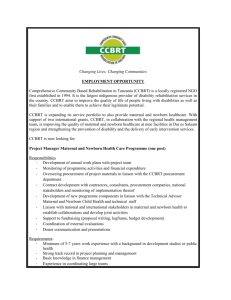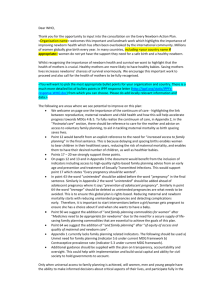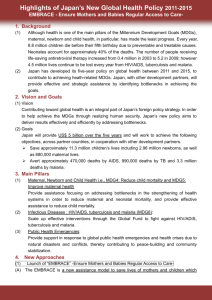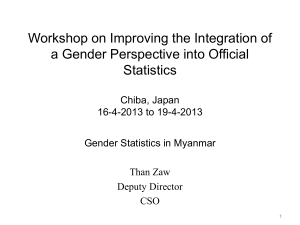Speech by World Bank Group President Jim Yong Kim at Maternal
advertisement
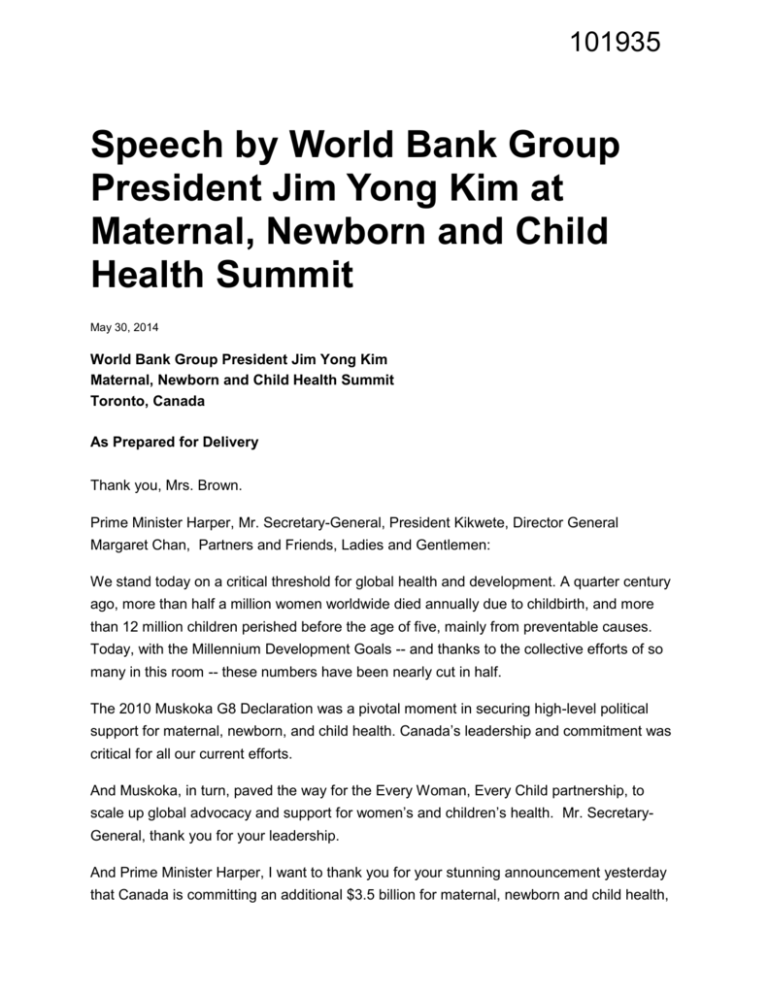
101935 Speech by World Bank Group President Jim Yong Kim at Maternal, Newborn and Child Health Summit May 30, 2014 World Bank Group President Jim Yong Kim Maternal, Newborn and Child Health Summit Toronto, Canada As Prepared for Delivery Thank you, Mrs. Brown. Prime Minister Harper, Mr. Secretary-General, President Kikwete, Director General Margaret Chan, Partners and Friends, Ladies and Gentlemen: We stand today on a critical threshold for global health and development. A quarter century ago, more than half a million women worldwide died annually due to childbirth, and more than 12 million children perished before the age of five, mainly from preventable causes. Today, with the Millennium Development Goals -- and thanks to the collective efforts of so many in this room -- these numbers have been nearly cut in half. The 2010 Muskoka G8 Declaration was a pivotal moment in securing high-level political support for maternal, newborn, and child health. Canada’s leadership and commitment was critical for all our current efforts. And Muskoka, in turn, paved the way for the Every Woman, Every Child partnership, to scale up global advocacy and support for women’s and children’s health. Mr. SecretaryGeneral, thank you for your leadership. And Prime Minister Harper, I want to thank you for your stunning announcement yesterday that Canada is committing an additional $3.5 billion for maternal, newborn and child health, beyond 2015. Once again, Canada is leading the charge to ensure that we meet our commitment to improve maternal health and reduce child mortality. Four years after Muskoka, it’s the right time to reflect on how far we’ve come. While we can point to progress, we know that it’s been uneven. Too many women and children are still dying because they lack access to quality health care – especially in the least developed countries. Over 6 million children under age five died in 2012 – that’s nearly 18,000 every day. The maternal and child mortality rates in the least developed countries are about 30 times those in high-income countries, with half the global burden in sub –Saharan Africa. It doesn’t have to be this way. A baby in Cameroon and a baby in Canada should have the same opportunity to be born safely, and to have her mother survive childbirth to care for her. The future should be brighter for every woman and every child. As the Lancet Commission on Investing in Health shows, a global convergence on maternal, newborn, and child health is possible within a generation – that is, if governments and donors invest sufficiently and smartly. And these investments will not only save lives, they will drive economic growth and prosperity. So what are the smartest investments? The first is results-oriented service delivery. Shifting our focus from inputs to paying for results has been proven to be extremely effective in getting high quality, essential health services to women and children. Empowering frontline health workers -- with the autonomy and resources to develop strategies to improve service delivery -- has resulted in transformational changes in access and quality. This results-oriented approach enables health systems to innovate, and become more efficient and accountable for delivering timely and quality services. Coupled with independent verification, it ensures accountability and transparency in the use of donor and government resources. The evidence of this approach speaks for itself: Argentina reduced neonatal mortality by 74 percent. In Zambia, the use of modern family planning increased by 109 percent in just one year. And in Zimbabwe, child immunization rates nearly doubled from 33 to 62 percent in a single year. I’m proud that the World Bank Group has been able to support mothers and children through our partnership in results–based financing. We’re supporting programs totaling 2.5 billion dollars in 32 countries. As they view results from our successful pilots, more governments are allocating their own budget resources to sustain and scale up successful programs. The Republic of Congo, for example, is providing $100 million dollars from its domestic budget to scale up the program nationwide -- that’s 80 percent of the total cost. We’re also excited to see our partners, such as UNICEF, GAVI and the Global Fund, leveraging this approach to provide additional in-country financial support. Results-based financing is helping us make progress on our promises at Muskoka and the promises of Every Woman, Every Child: More money for women’s and children’s health, and more women’s and children’s health for the money. So with 580 days to go until the deadline for the Millennium Development Goals, it’s time for all of us to double down. With an additional 510 million dollars in grant funding linked to IDA, we estimate that by 2020, we can save the lives of an additional 61,000 mothers and 1.1 million children, of which 56,000 are newborns. With an additional 1 billion dollars in grant funding, we can make an exponential leap and by 2020, save the lives of 183,000 mothers and 3.3 million children, including 1.7 million newborns. This more than doubles the pace of global death reductions. I urge every development partner and donor in this room to join with us and follow Canada’s lead to help scale up investments in maternal and child health. A second smart investment to improve maternal and child health is to build a wellfunctioning civil registration and vital statistics system. Prime Minister Harper, thank you for bringing much-needed attention to this issue. To stop mothers and young children from dying, we first need to know who is dying, from what causes, and where. Vital statistics systems are also a keystone of any country’s development infrastructure. Policymakers can’t plan and allocate resources effectively unless they have accurate data on the health and welfare of their citizens. Vital statistics promote accountability by providing a baseline for measuring progress, and for better targeting of health and other development programs -- like education and safety nets. And vital statistics provide legal rights to families, for example, in conferring property. Only 34 developing countries have high quality, easily accessible data on something as important as the causes of death for their citizens. Two-thirds of all deaths globally are not counted at all. In some countries, particularly in Africa, as many as 80 percent of deaths go unreported. Part of the problem lies in outdated, inaccurate definitions. Take the example of birth registration. The current definition of registration “at birth” is children registered by age 5. Only 10 percent of births are registered in the first year. This means that most still births and neonatal deaths go unregistered. This means that those lives are not counted. This is unacceptable – but it’s a problem that the global community can solve. We have the technology. In 2014, no country should have to rely on passive, paper-based records systems. We have the human resources. Health workers are present at vital events of birth and death, and we can empower them to record these events in real time. We have the know-how. If we can attend every delivery, then we can register every maternal and child outcome. Our vision is to register every single pregnancy and every single birth by 2030. In partnership with Canada and many others, we’ve developed a plan to improve and scale up existing registration systems. Every country should have a 21 st century, active, digital, and truly “vital” system. These smart investments in results-oriented service delivery and vital statistics systems will help countries achieve the goal of universal health coverage. More than one billion people lack access to health care, and about 100 million people fall into poverty every year from paying out-of-pocket costs for health care. Universal health coverage is the progressive pathway that will save lives, increase economic growth, and help millions of people lift themselves out of poverty. Universal health coverage and saving women’s and children’s lives are mutually reinforcing goals. Universal health coverage is about ensuring that everyone – women, men, and children – can access a package of essential health services. No one should fall into poverty or be kept in poverty to pay for the health care they need. Universal health coverage is about equity, and delivering on the social contract. A growing number of countries at all income levels are pursuing universal health coverage. They are responding to their emerging health needs and disease burdens, closing gaps in access to quality care, and protecting their poorest and most vulnerable populations. As more countries move toward universal coverage, fewer mothers die in childbirth, and more babies are born healthy. Peru has nearly doubled its health coverage from 37 percent to 65 percent of the population, which has helped lead to a significant reduction in maternal and child mortality. Ghana has nearly quintupled its health coverage from 6 percent to 35 percent of the population. Now, 30 percent of insured poor women deliver their babies in a health facility with a skilled birth attendant, as compared to just 10 percent for uninsured households. The December 2015 Millennium Development Goals deadline, and the emerging post-2015 development framework, present us with some critical choices. We can continue to invest in a myriad of health programs that are not very well-coordinated and have limited impact -- or, we can begin to consolidate and leverage our resources around the most equitable, effective, and efficient initiatives, backed by evidence. The people in this room have done some extraordinary things. As a global health and development community, we have collectively mobilized once unthinkable resources over the last decade and saved hundreds of millions of lives. Let’s leave this summit committed to deliver essential, quality health care to everywoman, every child, every family, everyone, everywhere. Thank you very much.


